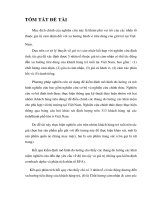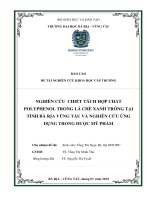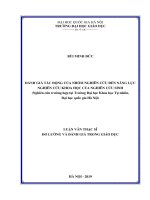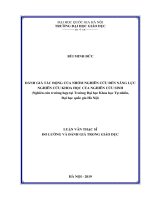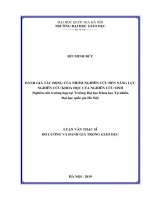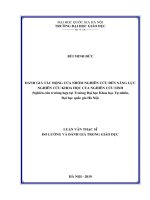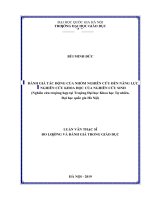NGHIÊN cứu về NGÔN NGỮ sử DỤNG TRONG THƯ tín KINH DOANH TRÊN PHƯƠNG DIỆN HÀNH VI lời nói và các CHIẾN lược LỊCH sự
Bạn đang xem bản rút gọn của tài liệu. Xem và tải ngay bản đầy đủ của tài liệu tại đây (310.32 KB, 71 trang )
ABSTRACT
English business letter has been an important and indispensable tool for us to
exchange information in global economy. Therefore, writing the efficient letters will
determine the success of business communication.
In order to find out the effective ways to write business letters, the study
intended to analyze inquiry letters and collection letters in terms of speech acts and
politeness strategies.
The study began with the literature review on speech acts and politeness
strategies. Then both qualitative and quantitative methods were applied in data
analysis to answer two research questions. The findings of the study presented speech
acts used in two kinds of letters and indicated the most dominant speech act. Besides,
tone and appeal which were two aspects of politeness strategies were investigated
carefully. From that, the suggestions for writing effective letters were drawn out.
This study hopefully makes a contribution an effective approach to the business
correspondence study.
i
TABLE OF CONTENTS
ACCEPTANCE i
ACKNOWLEDGEMENTS ii
ABSTRACT iii
TABLE OF CONTENT iv
LIST OF FIGURES AND TABLES vii
PART I: INTRODUCTION 1
1. Rationale of the study 1
2. Objectives of the study 2
3. Research questions 2
4. Scope of the study 2
5. Significance of the study 3
6. Method of the study 3
7. Organization of the study 3
PART II: DEVELOPMENT 5
CHAPTER I: LITERATURE REVIEW 5
1. Speech acts 5
1.1. Definition of speech acts 5
1.2. Classification of speech acts 6
1.3. Direct and indirect speech acts 8
2. Politeness 9
2.1. Definition of politeness 9
ii
2.2. Face 10
2.3. Politeness strategies 11
2.3.1. Lakoff and Leech’s politeness theory 11
2.3.2. Brown and Levinson’s politeness theory 13
3. Business letters in English and its properties 16
3.1. Business letters as special texts 16
3.2. The parts of a business letter 17
4. Inquiry letter 18
5. Collection letter 19
6. Related studies 19
CHAPTER II: METHODOLOGY 20
1. Selection of subjects 20
2. Research instruments 21
3. Data collection procedures 21
4. Data analysis methods and procedures 21
CHAPTER III: FINDINGS AND DISCUSSION 23
1. An analysis of inquiry letters and collection letters in terms of Speech
acts
23
1.1. Realization of Speech acts used in inquiry letters 23
1.1.1. Directives in inquiry letters 23
1.1.2. Representatives in inquiry letters 25
1.1.3. Expressives in inquiry letters 26
1.1.4. Commissives in inquiry letters 27
1.2. Overview of the use of Speech acts in inquiry letters 27
1.3. Realization of Speech acts used in collection letters 30
iii
1.3.1. Representatives in collection letters 30
1.3.2. Directives in collection letters 32
1.3.3. Expressives in collection letters 35
1.3.4. Declarations in collection letters 37
1.3.5. Commissives in collection letters 38
1.4. Overview of the use of Speech acts in collection letters 39
2. An analysis of inquiry letters and collection letters in terms of
politeness strategies
41
2.1. Application of politeness strategies in inquiry letters 41
2.1.1. Tone 41
2.1.2. Appeals 43
2.2. Application of politeness strategies in collection letters 45
2.2.1.Tone 45
2.2.2. Appeals 48
PART III: CONCLUSION 50
1. Summary of findings 50
2. Implication of the study 51
3. Limitations of the study 52
4. Suggestions for further studies 52
REFERENCE 54
APPENDIXES
APPENDIXE 1: Inquiry letters
APPENDIXE 2: Collection letters
iv
LIST OF FIGURES AND TABLES
List of figures
Figure 1: Flowchart of politeness strategies ordered against estimated threat to face
(Brown and Levinson, 1987:60)
Figure 2: Percentages of some Speech Acts used in the INQUIRY LETTERS
Figure 3: Percentages of some Speech acts in the COLLECTION LETTERS
List of tables
Table 1: The five general functions of speech acts (following Searle 1979)
Table 2: Basic types of direct speech acts
Table 3: Leech’s maxims
Table 4: Data of forty INQUIRY LETTERS
Table 5: Percentages of some Speech acts in the INQUIRY LETTERS
Table 6: Data of forty COLLECTION LETTERS
Table 7: Percentages of some Speech acts in the COLLECTION LETTERS
v
PART I: INTRODUCTION
This initial chapter states the rationale for the study, together with objectives,
scope, significance and method of the study. Also, an overview of the rest of the paper
is provided to orientate the readers throughout the study.
1. Rationale of the study
Vietnam is on the path of global integration in terms of science, education,
tourism, trade and other fields. Obviously, English has been becoming the effective
and indispensable means of communication among different countries in almost these
fields. Besides, with the development of international trade, business transactions are
conducted across borders, business partners communicate more often than ever.
Business communication can be taken in the form of face-to-face meetings or of
written communication known as business correspondence. English business letter has
been widely recognized as a typical written representative of communication and an
important tool in business dealings. Business correspondence brings quick transactions
for people in different distance places and for people who are unable to frequently
travel a long way for business discussions.
Politeness principle and speech acts are vital in writing business
correspondence because they determine the effectiveness and success of the
communication purpose of a business letter. In Vietnam, there are a few studies in the
area of business letters analysis. Therefore, this investigation may be considered as a
contribution to this field. Moreover, Vietnamese people need to have necessary
knowledge of writing business correspondence to maintain and develop the
international trade relationship between Vietnam and other countries in the world.
1
In the hope of finding how to write business letters effectively, I have chosen the
subject for my thesis: A study of language used in business correspondence in terms
of speech acts and politeness strategies.
2. Objectives of the study
Firstly, the research is expected to present, describe and analyze business letters
in terms of speech acts and politeness strategies.
Secondly, the researcher will give out the most dominant types of speech acts
and politeness strategies which are used.
Thirdly, from findings and discussion, the study makes some suggestion for
better writing business correspondence.
3. Research questions
The study was carried out with an aim to answering the two following
questions:
i. What are types of Speech acts that writers use in inquiry letters and
collection letters?
ii. What are politeness strategies that writers use in inquiry letters and
collection letters?
4. Scope of the study
Due to time limit and within the limitation of a graduation thesis, the research
cannot deal with all aspects of business correspondence. Therefore, it only
concentrates on speech acts and politeness strategies in business correspondence.
The object of this study focuses on two kinds of business correspondence, each
type has 40 letters:
2
Inquiry letter
Collection letter
5. Significance of the study
With theoretical background and data analyses based on language aspects, the
research is designed with a view to partly contribute to the better understanding of
business letters in terms of speech acts and politeness strategies. Besides, the
researcher expects to provide some suggestions for writing business letters for people
whose jobs or studies related to international business correspondence. Also, the
researcher hopes that this thesis would be a useful source of reference for further
studies on related topics.
6. Method of the study
This thesis uses both qualitative and quantitative methods to analyze two kinds
of business correspondence.
The main data used in this thesis are accumulated from the book “A Handbook
of Commercial Correspondence” by Oxford University Press in 1993, authentic
English letters from banks and from trading companies.
7. Organization of the study
The study is divided into three parts:
Part I (Introduction ) highlights rationale, objectives, scope, significance,
method and organization of the study.
Part II (Development) includes 3 chapters:
3
Chapter I (Literature review) provides the theoretical framework of the study,
including discussions of the theory of speech acts, politeness as well as the related
studies.
Chapter II (Methodology) describes the way the study is conducted, including
the research setting, participants, instruments of data collection as well as the
procedure employed to carry out data analysis.
Chapter III (Findings and discussion) presents and discusses the results that the
researcher found out from the collected data.
Part III (Conclusion) summarizes the key points, states the limitations and
suggests further studies.
4
PART II: DEVELOPMENT
CHAPTER I
LITERATURE REVIEW
This chapter provides the literature review including the notions of speech acts
theory, theory of politeness strategies, business letters in English and its properties,
the definition of inquiry letter and collection letter and it explains how the researcher
fulfills some related studies.
1. Speech acts
1.1. Definition of speech acts
Speech acts theory has been studied and differently defined by different
theorists such as: Austin (1962), Grice (1975), Hymes (1964), Searle (1969), Levision
(1983), Brown & Yule (1983) and others.
In Hymes’s definition (1964, p. 13): “Speech acts are defined as the acts we
perform when we speak” such as giving reports, giving advice, agreeing, complaining,
apologizing… A speaker in saying, for example: “I’ll help you whenever you need
me”, in fact, is making a promise or an act of promising. One may talk to her friend:
“Why don’t you tell him the truth?” This question, in certain contexts, may be
understood as a suggestion and the speaker is performing the act of giving advice.
According to Searle (1969, p.24), language is a part of a theory of action, and
speech acts are those verbal acts such as promising, threatening, requesting that one
performs in speaking.
Austin (1962, p. 52) originally uses the term “Speech acts” to refer to an
utterance and the “total situation in which the utterance is used”. In addition, Austin
5
(1962, p. 108) distinguishes three different kinds of actions which are performed when
a language user produces an utterance:
(i) Locutionary acts:
Locutionary act is simply the act that we perform in saying something or
producing a meaningful linguistic expression. For example, if we make a simple
sentence like “I want to have a gift for my birthday”, we are likely to produce a
locutionary act.
(ii) Illocutionary acts:
Illocutionary acts are performed via the communicative force of an utterance.
Austin gives out some examples of illocutionary acts like: informing, ordering,
warning, and undertaking, which have a certain (conventional) force. The illocutionary
force is the effect the speaker wants the utterance to have on the listener. For instance,
one may say “I think you spend much time playing games”, this is an act of
complaining.
(iii) Perlocutionary acts:
Perlocutionary acts are the effects of the illocutionary acts. Depending on the
circumstances, the Speaker will create an utter on the assumption that the Hearer will
recognize the effect the Speaker intended. For example, when saying “It’s cold in
here”, the Speaker wants the Hearer to close the door.
1.2. Classification of speech acts
In Searle’s view, illocutionary acts are the central to speech act theory. He
divided illocutionary acts into five categories: Declaratives, Representatives,
Expressives, Directives and Commisives.
6
(i) Declaratives are those kinds of speech acts that change the world via their
utterance with some typical verbs are: declare, pronounce, resign…
Example 1:
- Priest: I now pronounce you husband and wife.
- Referee: you’re out!
(ii) Representatives are those kinds of speech acts that state what the speaker
believes to be the case or not. They state facts, assertions, conclusion, and descriptions.
Example 2:
- The earth is flat.
- It was a warm sunny day.
(iii) Expressives are those kinds of speech acts that state what the speaker feels.
They express psychological states and can be statement of pleasures, pain, likes,
dislikes, joy, or sorrow. Some typical verbs used are: excuse, congratulate, and wish…
Example 3:
- I’m really sorry!
- Congratulation!
(iv) Directives are those kinds of speech acts that speakers use to get someone
else to do something. They express what the speaker wants. They are commands,
orders, requests, suggestions conveyed by verbs as order, command, request, allow…
Example 4:
- Give me a cup of coffee.
7
- Could you lend me a pen, please?
(v) Commisives are those kinds of speech acts that speakers use to commit
themselves to some future actions. They express what the speaker intends. They are
promises, threats, refusals, pledges demonstrated by verbs: pledge, swear, promise,
offer…
Example 5:
- I’ll be back.
- We will not do that.
Similarly, G. Yule (1996, p. 55) summarizes these five fundamental functions
of speech acts in a table:
Speech act type Direction of fit
S = Speaker;
X = Situation
Declarations words change the world S causes X
Representatives make words fit the world S believes X
Expressives make words fit the world S feels X
Directives make the world fit words S wants X
Commissives make the world fit words S intends X
Table 1: The five general functions of speech acts
1.3. Direct and indirect speech acts
In speech acts theory, there are two types of speech acts on the basis of
structure: direct and indirect. They are distinguished based on the relationship between
the structural forms and the communicative functions.
Structural forms Communicative functions
Declarative Statement
8
Interrogative Question
Imperative Command/ Request
George Yule (1996, p. 54) points out that: “We have a direct speech act
whenever there is a direct relationship between a structure and a function”. For
example, a speaker says: “close the window, please”, it means that the speaker directly
requests the hearer to close the window. In contrast, “whenever there is an indirect
relationship between a structure and a function, we have an indirect speech act”. For
instance, in the same situation with the previous example, the request can be made in a
more indirect manner to achieve the same result. The speaker may say: “it’s cold
outside” instead of “close the window, please”.
Concerning why indirectness is used, Yule (1996, p. 56) explains: “indirect
speech acts are generally associated with greater politeness in English than direct
speech acts”.
2. Politeness
2.1. Definition of politeness
Politeness plays an important role in interaction and has a great effect on the
use of speech acts in human communication. The two types of communication based
on the communication channels used are nonverbal communication and verbal
communication which is further divided into oral communication and written
communication. Therefore, the term “politeness” could be used to cover the study both
spoken and written language.
In the study in politeness theory, Leech (1980 and 1983) and Brown & Lesion
(1987) focus politeness as a pragmatic phenomenon. Leech defines politeness as a type
9
Table 2: Basic types of direct speech acts - G. Yule (1996, p. 54)
of behavior that allows the participants to engage in a social interaction in an
atmosphere of relative harmony. He claims that politeness principle is necessary to
rescue the cooperative principle (be true, be brief, be relevant, be clear), which is
based on Grice’s maxims (1975). Besides, John, Gumperz and several other authors
(in Brown and Lesion, 1987, p. 13) consider politeness as “basic to the production of
social order, and a precondition of human cooperation”.
Yule (1996, p. 60) defines politeness in the light of pragmatics: politeness is
seen as “the idea of polite social behavior or etiquette within a culture”. More
concretely, politeness “is a number of different general principles for being polite in
social interaction within a particular culture.
2.2. Face
“Face” closely relates to the concept of politeness. The understanding of notion
of “face” is significant to understand politeness. Like “politeness”, “face” is also
defined differently, but the content is similar. According to Richards (1992, p. 135),
“in communication between two or more persons, the positive image or impression of
oneself that one shows or intends to show to the other participants is called Face”.
Yule (1996, p. 60) defines “Face” as the public self-image of a person. The
concept refers to that emotional and social sense of self that everyone has and expects
everyone else to recognize and the author adds that “politeness, in an interaction, can
be then defined as the means employed to show awareness of another person’s face”.
If a person says something that represents a threat to another individual’s expectations
regarding self-image, it is considered as a face threatening face (FTA). Alternatively,
given the possibility that some actions might be interpreted as a threat to another’s
face, the speaker can say something to lessen the possible threat. This is called a face
saving act (FSA).
10
In terms of participant’s want, Brown and Levinson (1987, p. 62) distinguish
two types of face.
• Negative face is “the want of every competent adult member that
his actions be unimpeded by others”. It means that negative face is the basic
claim to territories, personal preserves, right to non-distraction. They are free
from action and imposition.
• Positive face is “the want of every member that his wants be
desirable to at least some others”. In other words, positive face is the positive
consistent self-image or personality claimed by interactants.
2.3. Politeness strategies
In order to avoid conflict and respect people’s freedom of thought, and maintain
the harmonious relations with others, politeness strategies can be implemented. For
example, people can soften a request by avoiding bare imperatives to maintain a
positive or negative face in a conversational situation. Therefore, it is suggested that
behaving appropriately, that is assuming to match the speakers and addressees’ need or
wish, can preserve either positive or negative self-image of the speaker or the hearer.
2.3.1. Lakoff and Leech’s politeness theory
R. Lakoff (1973, p. 32) stated that politeness is “a system of interpersonal
relations designed to facilitate interaction by minimizing the potential for conflict and
confrontation inherent in all human interchange”. R. Lakoff points out three different
rules a speaker might follow in choosing to be polite:
Rule 1: Don’t impose (used when formal/impersonal politeness is
required).
11
This can be understood as meaning: remain aloof, do not intrude into other
people’s business. It is used to avoid or ask for permission or apologize for making
addressee (A) do anything which A does not want to do.
Rule 2: Give options (used when informal politeness is required).
It is used to let A (addressee) make his own decisions – leave his options open
for him.
Rule 3: Make A (addressee) feel good – be friendly (used when
intimate politeness is required).
It is often used conventionally when there is no real friendship left. This is the
rule that encourages feelings of camaraderie between Speaker and Addressee. The
main aim is to make the Addressee feel good and produce a sense of equality between
Speaker and Addressee.
On the other hand, Leech (1983, p. 132) introduces a number of maxims based
on the cost and benefit to the Hearer and the amount of optimality given to the Hearer.
The main maxims are:
Tact maxim
Minimize the cost to another
Maximize the benefit to another
Generosity maxim
Minimize benefit to ourselves
Maximize the cost to ourselves
Approbation
maxim
Minimize dispraise of other
Maximize praise of other
Modesty maxim
Minimize praise of ourselves
Maximize dispraise of ourselves
Agreement maxim
Minimize the expression of disagreement between self and
other
Maximize the expression of agreement between self and other
12
Sympathy maxim
Minimize antipathy between self and other
Maximize sympathy between self and other
2.3.2. Brown and Levinson’s politeness theory
According to Brown and Levinson (1987), politeness strategy is concerned with
the actions people take to maintain their face and that of the other people they are
interacting with. Besides, politeness is realized linguistically by means of various
strategies (positive and negative) across cultures.
Positive politeness involves a face-saving act which is concerned
with the person’s positive face. Positive politeness consists of acts which are
designed to perverse or restore the Hearer’s positive face by stressing the
Speaker’s sympathy with a social closeness to the Hearer. The use of positive
politeness forms, emphasizing closeness between speaker and hearer, can be
seen as a solidarity strategy. One linguistic way of doing this would be to
include both Speaker and Hearer in the activity.
Eg: “Let’s go to school together”.
Negative politeness involves a face-saving act which is concerned
with the person’s negative face. Negative politeness consists of acts which are
designed to perverse or restore the Hearer’s negative face by expressing the
Speaker’s reluctance to impose his or her want on the Hearer and/or by
acknowledging the social distance between the Speaker and the Hearer. The use
of negative politeness forms, emphasizing the hearer’s right to freedom, can be
seen as a deference strategy. One way of doing this would be to use hedge.
Eg: “I know you’re busy, but can you help me do my homework?”
13
Table 3: Leech’s maxims
From the face-saving view, Brown and Levinson propose five politeness
strategies to minimize risk of losing face corresponding to the degree of face-threat.
The greater the risk of face loss is, the higher-numbered strategy will be employed.
Strategy 1: Bald on record
Eg: - A says to C: “You can’t smoke here.”
Strategy 2: Positive politeness
Eg: - “You know they do have a section for smokers over there. Let’s go find it
so you can have a cigarette.”
Strategy 3: Negative politeness
Eg: - Would you mind our asking you not to smoke in the nonsmoking
section?”
Strategy 4: Off record (implicating)
Eg: - A says to B so that C can overhear: “I wonder if there is a smoking
section.”
Strategy 5: Don’t do the FTA (refraining from the act)
Eg: C is smoking and A&B move away (No linguistic action).
They specify that speakers should respect each other’s expectation regarding
self-image, take account of their feelings, and avoid Face Threatening Acts (FTAs –
acts which threaten the face wants of the speaker, the hearer, or both of them). They
also propose 4 kinds of FTAs:
1. Acts threatening to the Hearer’s negative face
14
E.g: ordering, suggesting, advising, reminding, threatening, warning, offering,
promising, complimenting.
2. Acts threatening to the Hearer’s positive face
E.g: disapproving, complaining, criticizing, disagreeing, accusing and raising
taboo topics.
3. Acts threatening to the Speaker’s negative face
E.g: accepting an offer, accepting thanks, excusing, promising unwillingly.
4. Acts threatening to the Speaker’s positive face
E.g: apologizing, accepting compliments, and confessing.
Brown and Levinson summarized a taxonomy of possible strategies for
performing FTAs in the following chart:
15
Without redressive
action, baldly
lesser less
greater more
On record
Speaker’s estimation
of threat to face
Overall Politeness of
speech act
Do FTA
Positive
politenes
s
Off record
With redressive
action
Negative
politenes
s
3. Business letters in English and its properties
3.1. Business letters as special texts
Business letters are often said to be the “ambassador” of an enterprise because
it is, first of all, the principle means used by the enterprise to keep in touch with its
customers; and customers form their impression of the enterprise from the tone and the
quality of the letter it sends out. (Nguyen Trong Dan, 1997, p. 3)
Any text always consists of structure and business letters are special texts.
Therefore structures are cohered to build up texts.
Like other texts, business letters have a clearly communicative purpose,
therefore, these types of texts will have some linguistic features denoted the inside
relationships of the texts and their own styles. Business letters with the seven “C’s” of
style will help you become more effective. The seven “C’s” are Convention, Clear,
Concise, Complete, Concrete, Constructive and Correct.
The four areas you must take into consideration for each business letters are
listed rhetorically as: Subject – Audience – Purpose – Style/Organization. Many letters
are sent with a specific subject and audience in mind, but are not clear in their purpose.
You must know why you are sending the letter and if the reader is to inform, if it is to
16
Don’t do FTA
Figure 1: Flowchart of politeness strategies ordered against estimated threat to face
(Brown and Levinson, 1987, p. 60)
request information, and if it is to get the recipient to act on a request. All of these are
very different purposes. You have probably received a letter that, after reading it, left
you confused because you did not know exactly what it said as the purpose is not
clear.
3.2. The parts of a business letter
Business letters have many parts, some are compulsory and some are optional.
They may include:
1. Letterhead or Heading: The heading portion of a business letter
includes the writer's address.
2. Dateline: the date on which the letter is being prepared is typed a
few lines below the letterhead.
3. Inside address: The inside address shows the name and address of
the recipient of the letter.
4. Attention line: this is not always required. It should be used when
the letter is addressed to a company or organization as a whole, but you want it
to be handled by a specific individual at the company or within the
organization. It should be underlined or typed in capitals.
5. Salutation: this appears below the name and the address of the
recipient (to whom the letter is written).
- Dear Sir opens a mail to a man whose name the sender does not know.
- Dear Sirs is used to address a company.
- Dear Madam is used to address a woman, whether single or
married, whose name the sender does not know.
17
- Dear Sir or Madam is used to address a person of whom the
sender knows neither the name nor the sex.
- When the sender knows the name of the receiver, the salutation
takes the form of Dear followed by a courtesy title and the receiver’s surname.
Initials or first names are not generally used in salutations: Dear Mr. Smith, not
Dear Mr J. Smith.
The comma after the salutation is optional (Dear Sir, or Dear Sir).
6. The body of the letter: this part contains message or information
which the writer wants to communicate. The body of the letter should be
divided into different paragraphs.
7. The complimentary close: this should always agree with
salutation and it must always be followed by a comma.
- If the letter begins with Dear Sir/Sirs/Madam/Sir or Madam, it
will close with Yours faithfully.
- If the letter begins with Dear Mr. James/Mrs. Robinson/Ms.
Jasmin, it will close with Yours Sincerely.
- The comma after the complimentary close is optional (Yours
faithfully, or Yours faithfully.)
8. Signatures: the complimentary close will be followed by the
signature of the writer.
4. Inquiry letter
“A letter of inquiry is usually written to ask for specific information or sale
literature about products and services, price lists, catalogs, terms of payment,
quotations, discount schedules, dealer prices, the name of a dealer or a local supplier,
18
or free samples or materials. Letters of inquiry are also referred to as request letters.”
(Alan J. Bond, 2005, p. 9). The term ‘Inquiry’ is same as ‘Enquiry’. The former is
more commonly used in U.S. and the latter one is more common in U.K.
5. Collection letter
Collection letters are normally sent out to customers to remind them of
payments due for goods or services delivered or rendered by a company. Collection
letters are generally written in a series with increasing degrees of urgency and
insistence. The first collection letter is mildest and most understanding, with the
following letters getting gradually more insistent. The final letter in this series, when
all efforts have failed, gives customers one last brief period to respond before taking
action to turn the matter over to a lawyer or collection agency or court of law. An
effective letter of collection achieves its purpose without destroying the customers'
goodwill.
6. Related studies
In Vietnam, there are not many researchers attempting to analyze business
correspondence in terms of speech acts and politeness strategies. They focused mainly
on grammatical features and discourse analysis. However, the writer was still inspired
by Ngô Tùng Anh’s study “Analysis of the Language Often Used in Banking Business
Letters in Terms of Structure and Speech Acts” (1997). In his thesis for the degree of
Master of Art, Ngo Tung Anh seemed to take the first step in finding out speech acts
use in business letter included inquiry letter and collection letter. Nevertheless, he gave
overview of speech acts in each type of sentence presented in a table.
For those limitations of this study, the researcher came up with a decision to
conduct this thesis so as to bring more deep and detailed analysis on inquiry letter and
collection letter in terms of speech acts and politeness strategies.
19
CHAPTER II
METHODOLOGY
This chapter describes the way the research is conducted, including the
selection of subjects, instruments of data collection, procedures of data collection as
well as the methods and procedures employed to carry out data analysis to answer the
research questions:
1. Selection of subjects
Business correspondence consists of many different kinds. However, two types
of business letters which are appropriate to analyze in terms of speech acts and
politeness strategies are chosen.
Subjects for this study are:
Inquiry letters
Collection letters
The main data used in this thesis are collected from the book “A Handbook of
Commercial Correspondence” by Oxford University Press in 1993, authentic English
letters from banks and from trading companies. However, due to the confidentiality of
authentic business letters, the number of data in these sources is limited.
2. Research instruments
The document is the predominant instrument used to collect data for the
research. The document includes two types of business letters (inquiry letter and
20



